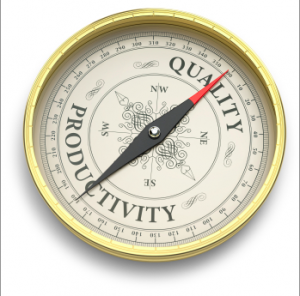A colleague told me he hadn’t realized that when I talk about innovation I am often referring to improvements in processes, workflows, and efficiency, in addition to new product and service developments. So, let me set the record straight.
According to The Oxford American Dictionary, innovation is defined as: n. Change, alteration, revolution, upheaval, transformation, metamorphosis, breakthrough; new measures, new methods, modernization, creativity, ingenuity, inspiration….
Therefore, "change" and "new methods" can be something as modest as altering the steps in verifying data to ensure greater accuracy, or ordering a piece of equipment so that fewer people need to be involved. Minor “tweaks,” collectively, can be world changing. Toyota became the largest and “most efficient” car manufacturing company in the world not based on revolutionary, head-turning Tesla-like designs (although it has certainly has had breakthrough designs of its own). What Toyota has mastered is a whole other realm of innovation:
Improving Processes — Keeping it Simple in the Spirit of "Kaizen"
It is important not to conflate an openness and commitment to improving processes with adopting formal process improvement systems such as Lean and Six Sigma. A future blog post will provide a high-level overview Lean and Six Sigma, as well as Agile. In short (while there is some interrelationship between them) these are disciplined, multi-step methodologies for revealing and eliminating: a) waste in time, energy, and resources (Lean); b) inconsistencies in production quality (Six Sigma), and c) for speeding up development and leaning cycles (Agile). The latter, Agile, has been primarily used in software development, but many believe its use would improve the outcomes and efficiency of most projects.
There are times when these frameworks utilize creative thinking, and at others, the intense drive for speed and exact measurement can stifle it. In order to maximize the benefits of divergent thinking, depending on the stage of the cycle within any one of these methodologies, process leaders must hold fast to a commitment to balance, and ensure there is sufficient time for the creative ideation and reflection process.
Toyota has honed each of these systems to a high art. But they are viewed only as tools within their overarching approach called "Kaizen,” which is Japanese for “change for the better” or “continuous improvement.” Kaizen itself is not a specific tool, but rather, it is a mindset or value system, and a "journey."
 With the belief that everything can be improved and performed more efficiently, and that continuous improvement is everyone's business, just as the stand-out leaders in the IBM CEO study did, Toyota requests every one of its employees to help "identify problems and then develop and implement ideas to solve [them]." (My most recent information estimates all Toyota employees contribute an average of ten improvement suggestions per year, from line-workers, to administrative assistants.)
With the belief that everything can be improved and performed more efficiently, and that continuous improvement is everyone's business, just as the stand-out leaders in the IBM CEO study did, Toyota requests every one of its employees to help "identify problems and then develop and implement ideas to solve [them]." (My most recent information estimates all Toyota employees contribute an average of ten improvement suggestions per year, from line-workers, to administrative assistants.)
In the spirit of Kaizen, in this article, we are referring to improving processes in its simplest form. On any given day at our work, most of us have ideas pop into our heads for how things could be more efficient or effective. Innovation management expert Langdon Morris writes that “seeing things as they are and things as they could be” is the creative tension that is foundational to innovation.
Many American companies that have adopted Lean and Six Sigma tools have fallen short of achieving the results that their Japanese counterparts have. Some ascribe this to a failure to fully understand the art of kaizen and the balance between:
- Applying the rigorous systems of Six Sigma, and Lean
- With taking adequate time for divergent thinking and stepping back
- With drawing creative continuous improvement ideas from the ingenious rank-and-file humans who come to work for them every day.
Unless leaders put processes in place for employees to share their ideas, and then to vet them and experiment with those that may be viable, rhetoric aside, they are not creating innovative workplaces. The cost of not implementing these is a tremendous loss of brainpower, opportunities, and financial and human resources. Regardless of what great employee benefit programs are offered, their organizations' rates of dissatisfaction and turnover will be higher than had they engaged the talents of their employees in continuous improvement.
Other Forms of Innovation:
Now that we've explored the over-arching concept of process improvement, let's look at some other viewpoints. Brownell Langdrum of Draw Success (www.DrawSuccess.com) supplemented her own list of types of innovation with those generated by a group of chief innovation officers from companies such as Google, Mattel, and Hewlett-Packard. A few of these are included below; some overlap, and some "hairs might be getting split." But it's an interesting prompt for thinking through the various areas where we can take our questions and wonder if there might be better ways… (In looking at her full document, you will find that some of the descriptions are quite original themselves.)
Improvements in internal operations:
- Efficiency Innovation delivers ways to improve efficiency and the speed of effectiveness. It can include internal systems and processes or ways to expedite the customer/client experience.
- Financial Innovation conveys ways to increase sales, reduce costs, improve tracking of expenses, and reduce accounts receivable, along with other ways of managing finances to enhance profitability. It also includes ideas to improve tax/audit compliance.
- Process Innovation encompasses the implementation of a new or significantly improved production or delivery method.
- Systems Innovations includes introducing a new infrastructure or system, which could produce new sectors, and induce major change across several areas of business.
 And now for the Flashier forms of Innovation:
And now for the Flashier forms of Innovation:
- Breakthrough, disruptive or radical innovation: These involve launching entirely novel products or services. Breakthrough innovations are rare because of the risk and uncertainty, but they can deliver tremendous rewards. They require large leaps of thought and a high risk tolerance.
- Business Model Innovation involves changing the way business is done, whether in terms of sales and distribution, marketing, pricing or any other core business strategy.
- Incremental Innovation is when one adds something extra to a product or service that the competition doesn't have or isn't doing. Or, when one makes something last longer, makes it more convenient, or faster.
- Marketing Innovation involves development of new marketing methods with improvements in product design or packaging, product promotion, communication or advertising, pricing or distribution.
- Product Innovation is the introduction of a good or service that is new or substantially improved, which may include improvements in functional characteristics, technical abilities, ease of use, or any other dimension.
- Service Innovation: Compared to goods or product innovation or process innovation, service innovation delivers ways to improve the delivery of a service or expertise and is both interactive and information-intensive.
- Technological Innovation may include coming up with new technologies to solve a problem or new uses for existing technologies. Solutions may be high-tech (i.e. computer systems) or low-tech (a better mouse trap).
In summary, when hearing or using the term “innovation,” be aware that it often refers to simple improvements in workflows and processes. Creating environments that challenge all employees to help lead continuous improvement can result in organizational benefits that go far beyond what any one mind could ever have imagined.

 How would you feel if many people thought you were the smartest person in history? How might your life be different if you actually were that intelligent? Although we often think of Albert Einstein as one of the smartest people ever, we don’t investigate what it was that made him so. People who speak highly of him often attribute his genius to some mysterious gift. They don’t believe his smarts came from a certain attitude about learning. I believe you can recreate some of his habits to get smarter and find more rewarding work.
How would you feel if many people thought you were the smartest person in history? How might your life be different if you actually were that intelligent? Although we often think of Albert Einstein as one of the smartest people ever, we don’t investigate what it was that made him so. People who speak highly of him often attribute his genius to some mysterious gift. They don’t believe his smarts came from a certain attitude about learning. I believe you can recreate some of his habits to get smarter and find more rewarding work.


